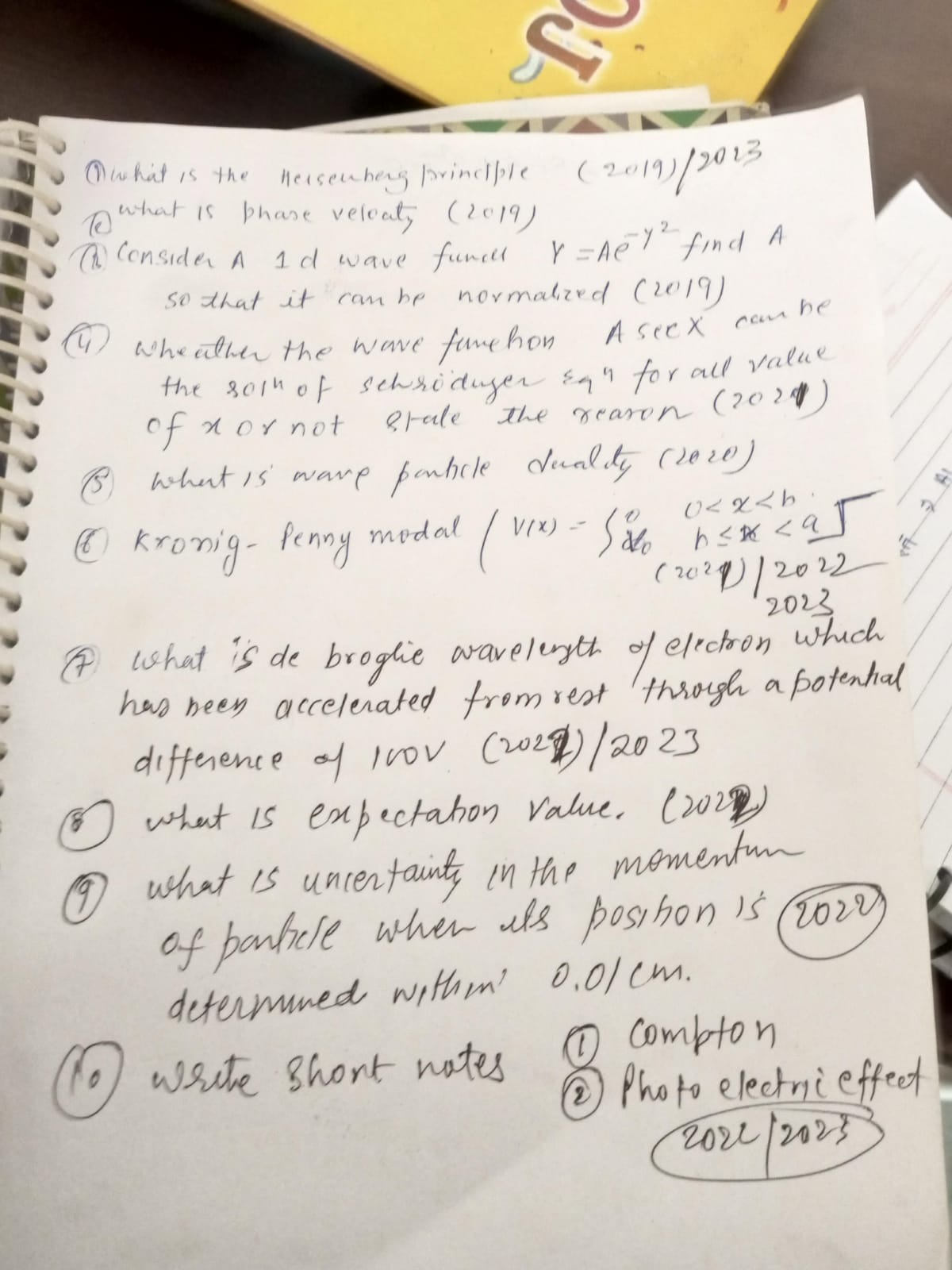1. What is the Heisenberg principle? 2. What is phase velocity? 3. Consider a 1D wave function Y=Ae^(-y^2), find A so that it can be normalized. 4. Whether the wave function A sec(... 1. What is the Heisenberg principle? 2. What is phase velocity? 3. Consider a 1D wave function Y=Ae^(-y^2), find A so that it can be normalized. 4. Whether the wave function A sec(x) can be the solution of the Schrödinger equation for all values of x or not? 5. What is wave-particle duality? 6. Kroonig-Penny model: V(x) = 0 for 0 < x < b, otherwise V(x) = -V0 for a < x < a+b. 7. What is de Broglie wavelength of an electron which has been accelerated from rest through a potential difference of 100V? 8. What is expectation value? 9. What is uncertainty in the momentum of a particle when its position is determined within 0.01 cm? 10. Write short notes on Compton effect and Photoelectric effect.

Understand the Problem
The questions in the image are related to various concepts in physics, primarily focusing on quantum mechanics and wave phenomena. Each question asks for explanations or calculations related to wave functions, particle behavior, and specific models in physics.
Answer
1. The Heisenberg principle states the impossibility of precisely determining position and momentum of a particle simultaneously.
- The Heisenberg principle states that it is impossible to simultaneously know the exact position and momentum of a particle. 2. Phase velocity is the rate at which the phase of the wave propagates in space. 3. To normalize the wave function Y=Ae^(-y^2), find A by ensuring the integral of the absolute square of the wave function over all space is 1. 4. The wave function A sec(x) cannot be a solution of the Schrödinger equation for all values of x because sec(x) is undefined for x = (2n+1)π/2 where n is an integer. 5. Wave-particle duality refers to the concept that every particle or quantum entity may be described as either a particle or a wave. 6. The Kronig-Penny model describes the behavior of electrons in a 1D periodic potential, with the given potential V(x). 7. The de Broglie wavelength of an electron accelerated through a potential difference of 100V can be calculated using the formula λ = h / √(2meV), where h is Planck’s constant, m is the electron mass, and V is the potential difference. 8. The expectation value is the weighted average of all possible values of a variable in quantum mechanics. 9. The uncertainty in the momentum of a particle when its position is determined within 0.01 cm can be found using the Heisenberg uncertainty principle ΔxΔp ≥ ħ/2. 10. The Compton effect involves the scattering of X-rays by electrons, resulting in a change in energy (and wavelength) of the X-rays. The photoelectric effect refers to the emission of electrons from a material when light shines on it.
Answer for screen readers
- The Heisenberg principle states that it is impossible to simultaneously know the exact position and momentum of a particle. 2. Phase velocity is the rate at which the phase of the wave propagates in space. 3. To normalize the wave function Y=Ae^(-y^2), find A by ensuring the integral of the absolute square of the wave function over all space is 1. 4. The wave function A sec(x) cannot be a solution of the Schrödinger equation for all values of x because sec(x) is undefined for x = (2n+1)π/2 where n is an integer. 5. Wave-particle duality refers to the concept that every particle or quantum entity may be described as either a particle or a wave. 6. The Kronig-Penny model describes the behavior of electrons in a 1D periodic potential, with the given potential V(x). 7. The de Broglie wavelength of an electron accelerated through a potential difference of 100V can be calculated using the formula λ = h / √(2meV), where h is Planck’s constant, m is the electron mass, and V is the potential difference. 8. The expectation value is the weighted average of all possible values of a variable in quantum mechanics. 9. The uncertainty in the momentum of a particle when its position is determined within 0.01 cm can be found using the Heisenberg uncertainty principle ΔxΔp ≥ ħ/2. 10. The Compton effect involves the scattering of X-rays by electrons, resulting in a change in energy (and wavelength) of the X-rays. The photoelectric effect refers to the emission of electrons from a material when light shines on it.
More Information
The Heisenberg uncertainty principle is fundamental in quantum mechanics, emphasizing the limitations of measuring specific pairs of variables. For example, the more precisely one measures the position of a particle, the less precisely one can know its momentum, and vice versa.
Sources
- Solved Problems on Quantum Mechanics in One Dimension - phas.ubc.ca
- Wave functions - Physics LibreTexts - phys.libretexts.org
- Chapter 2. 1D Wave Mechanics - commons.library.stonybrook.edu
AI-generated content may contain errors. Please verify critical information